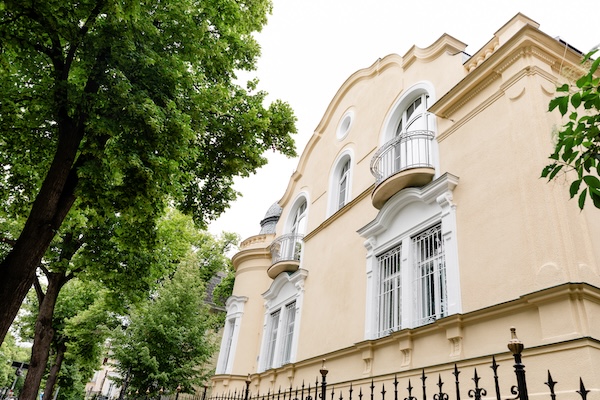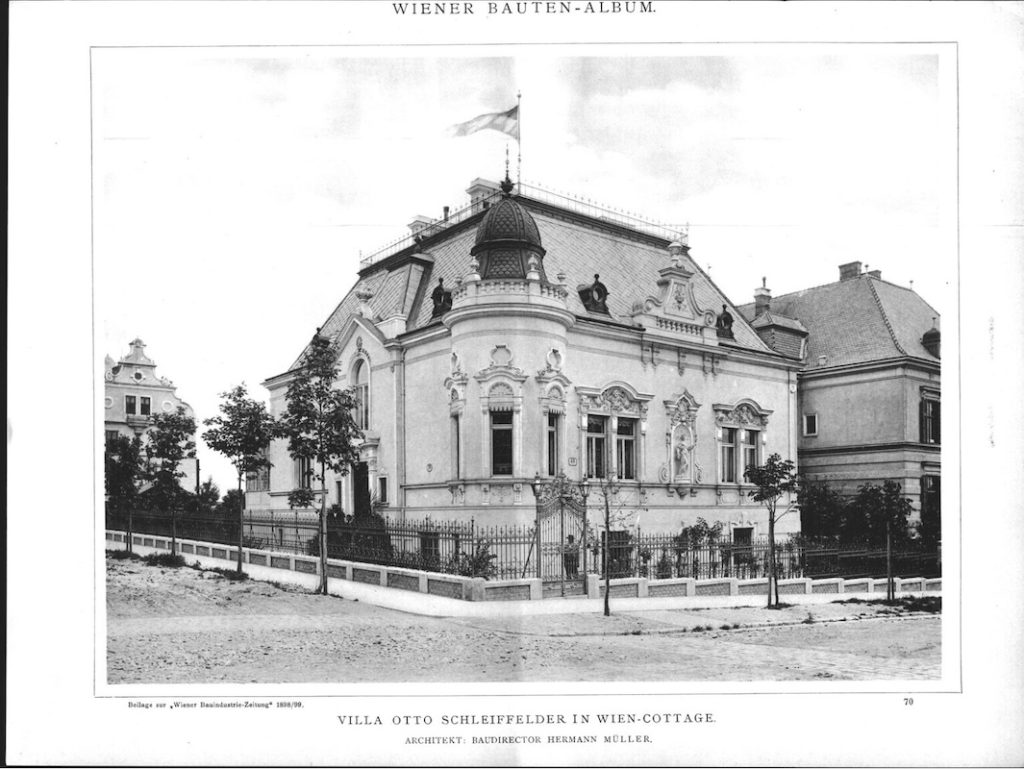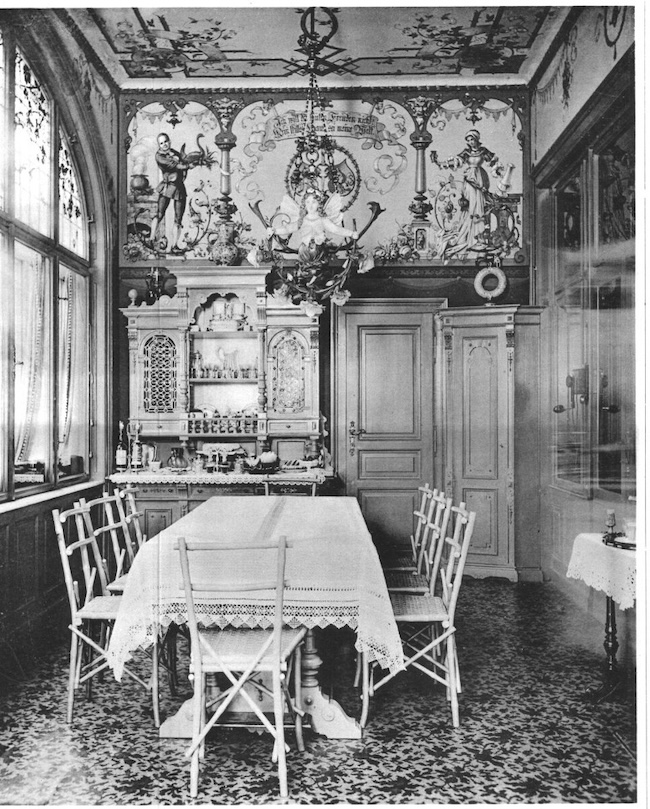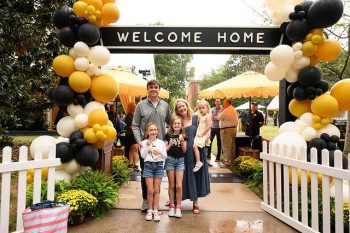
The history of Flow House, a mansion constructed in 1896-97, holds many stories of intrigue, from its time as the home of a wealthy business owner who built it for his family to later residents who fled Nazi Germany’s takeover of Austria during World War II.
Wake Forest knew many of the historical details when it bought the Schleiffelder Villa from the U.S. Embassy in Vienna in 1998. The purchase was possible thanks to a donation from Vic Flow (’52, P ’83) and his wife, Roddy Flow (P ’83), namesakes of the study-abroad house.
For the study-abroad program’s 25th anniversary celebration in May, retired Professor of History Charles “Chuck” Thomas (P ’04, ’12) worked with a team formed by the University’s Center for Global Programs & Studies to dig deeper into the history of the villa and its elegant “Cottage Quarter” neighborhood. Thomas taught at Flow House when his wife, Professor Emeritus of German Rebecca Thomas (P ’04, ’12), taught there for three semesters and was program director from 2019 until the couple’s retirement in July.
The research led to a book that is available to review at Z. Smith Reynolds Library or at the Global program’s office on campus, or read the text of the book online.
A Baroque city’s origins
Flow House sits in Vienna’s 19th District, an area with mansions, diplomatic residences and charming smaller homes. It was a place of agriculture and wine-making for most of its history — when it wasn’t devastated by invasions of Austria, the biggest by Hungarians in 1482 and Ottoman Turks in 1529 and 1683.
Vienna developed from ancient Celtic and Roman settlements into a medieval and Baroque city that became the capital of the Austro-Hungarian Empire, ruled by the Habsburg dynasty until World War I.
Between 1830 and 1869, Vienna more than doubled in population to 900,000, partly by annexing adjacent communities but largely because of the influx of working-class and military officers and families. They crowded into tenement rooms, largely outside the 1st District home of imperial palaces and aristocratic mansions.

In 1872, the British “cottage movement,” aimed at improving urban conditions to create more social stability, began to take hold in Vienna. Austrian advocates, eventually with royal support, hatched a plan to build and sell single-family or duplex homes on installment plans, mostly on cheaper land in the outer 18th and 19th Districts. The designs, while not fancy, required backyard lawns and greenery.

By the late 1800s, the “Cottage Quarter,” with green open spaces, was attracting higher-class families who built bigger, more luxurious garden villas. When Otto Schleiffelder’s villa was completed in 1897, average prices had risen sevenfold since 1872, pricing out many middle-class families.
Schleiffelder, born to German-speaking parents in the Austrian Empire at the juncture of Romania, Serbia and Hungary, had emigrated to Vienna. His retail optical business thrived, selling luxury items such as riding glasses, driving glasses and opera eyewear. He and his American-born wife, Emilie, raised their three sons and a daughter in their 11,000-square-foot home, which included a wine cellar, playroom/gymnasium and an outdoor garden pavilion resembling an alpine cottage. Servants lived on the top floor, where Wake Forest students now reside.
The patriarch’s death
Schleiffelder and his family avidly participated in the up-and-coming sport of yachting, and it was a boating accident that led to his death at age 62, on Aug. 18, 1909, the birthday of ruler Franz Josef.
During the family’s usual summer stint in Strobl to enjoy their multiple yachts, family members headed back from a day on Lake Wolfgang, with Schleiffelder and guests in his primary yacht and two of his sons, Emil and René, with guests in another boat.
A storm with gale-force winds arose suddenly.

Accounts of the patriarch’s death varied. An early report said wind shattered the boat’s mast, which fell on Schleiffelder and killed him, noting in a hint of scandal that an unnamed woman swam to safety. A second report said wind capsized the boat, throwing him and the passenger, this time identified as his daughter, into the water, where he died of a heart attack, exertion or fright. A still-later telegram from Emil said his father’s passengers were a Fräulein Bankmann from Vienna and Monsieur René de Fourchault from Paris. It said wind drove the boat near the shore, where the father was thrown into the waves and retrieved by his sons, but he had died from internal injuries, a village doctor verified the next day.
Despite this tragedy, the family’s passion for yachting continued until the eve of World War I, and the Schleiffelder business prospered under Emil’s leadership until his death in 1934. By 1914, however, family members had moved out of the villa to be closer to the city center, emigrate to the United States or serve in the military.

In the next four decades, three women owned the villa, all with unusual stories:
The first, 30-year-old Mathilde Bauer Lazarus Emine Bey, had married at age 17, had a daughter, divorced and remarried. She and her second husband invited into the villa a self-proclaimed princess from the Caucasus region. The flamboyant guest, who eventually lived in the Ritz and other city-center hotels, amassed large debts, including today’s equivalent of $23,000 owed to a baker for Viennese Semmel (distinctive Kaiser rolls).
The next owner was Nelly Taussig Adler, the 26-year-old Jewish daughter of a businessman. She lived there only briefly, if ever, but her father, his wife, a tenant and a custodian lived there until they all fled the German Nazi regime that invaded Austria in 1938. All, including Adler, eventually made their way through other countries to the United States.
Adler, like many Jews, had to sell her home quickly. The neighbor who bought it contested Adler’s attempt to recover the house after the war, but Adler successfully sued for restitution and regained ownership. At that point, she was working as a nurse’s aide in Connecticut. She sold the villa in 1950 to the U.S. Embassy, which in turn sold it to Wake Forest in 1998.
– Carol L. Hanner
Carol L. Hanner retired in 2024 after a newspaper career and nearly six years as managing editor of Wake Forest Magazine. She lives in Porto, Portugal.


